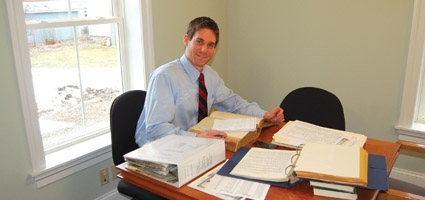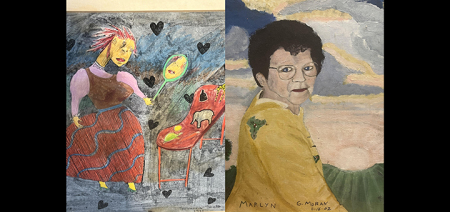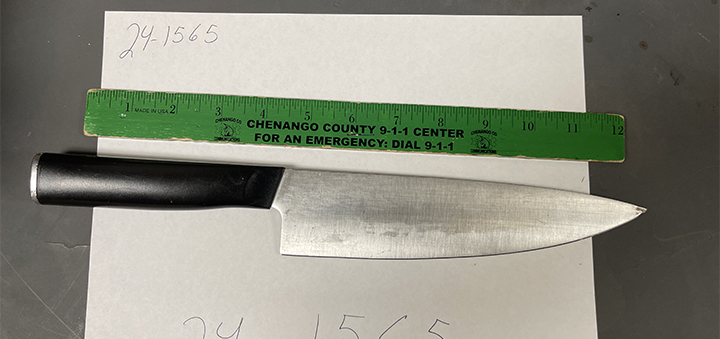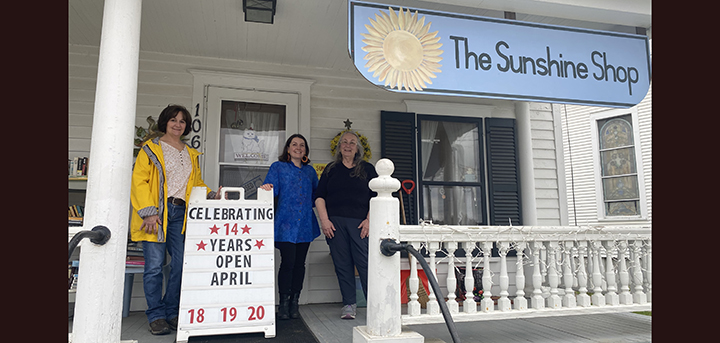Punching The Clock: History Lesson
Published:
February 20th, 2013
By:
Kevin Doonan

For this week’s edition of Punching the Clock, I headed over to the Chenango County Historian’s Office. Although I am by no means a doctoral candidate, I did study history as a undergraduate and I am oddly comfortable spending hours on end with my nose pressed to the page of ancient and obscure manuscripts. Upon my arrival, I was immediately whisked away on a whirlwind tour of the county historian’s new abode.
The county historian and historical research assistant have recently relocated to the building adjacent to the one they had previously shared with the county historical society on Rexford Street. The new location still smells of recently treated wood and freshly painted walls; natural light pours into the build’s spacious interior from multiple windows in stark contrast with the cramped, windowless basement the county historian recently vacated.
“We have volunteers who come in to do their own research projects and we always have plenty of projects for people to work on,” county historian Patricia Evans told me as she concluded my tour behind the front desk where historical research assistant Joan Lieb sits. And once the tour was done, I was put on the spot.
“What would you like to research?” Lieb asked me, as she and Evans both looked at me expectantly, their eyes betraying their eagerness to hear my choice which would indubitably be both spectacular and imaginative.
I stuttered, unable to think, my palms sweating with nervousness as I hurriedly racked my brain for a subject.
“How about something which is coming up or something you are working on?” Lieb helpfully suggested.
Then it hit me... I’ll take the Sherwood for $300, please.
Their faces were crestfallen, clearly disappointed with my mundane choice and having no doubt anticipated a more interesting topic. But Sherwood it was to be, having just visited the Greene hotel for a story on the renovations currently underway, and I was curious to learn more about the old landmark.
With Lieb and Evans’ aid I began my inquiry. Sorting through filing cabinets marked Business and Greene, we came up with the beginnings of my reading material. With the documents at hand I settled down at one of the public research desks before sinking my fangs into the dusty old tomes (they weren’t really dusty; frayed around the edges at most). Almost immediately I discovered the Sherwood was not the first lodging to be constructed at that site. In fact, two other public lodges had been built on the same location before the Sherwood first opened its doors in 1913.
The village of Greene had formed on March 1, 1798 out of land absorbed from the Town of Union, segments of Broome County, and Jericho (now Bainbridge), and was named after the famous Revolutionary War General Nathanael Greene, “The Fighting Quaker.” Five years later, the first framed building in Greene was constructed on the location where the Sherwood now stands, by Thomas Wattles, who dubbed the structure Waddle’s Tavern (the name might have actually been Wattle’s Tavern, which would make more sense, but Waddle was how my source spelled it).
In 1837, the Chenango House took the place of the Waddle’s Tavern, even though it had not burned down, which was something its successors seemed to find trendy. The Chenango House was an immense building constructed by Alvah Hunt, Col. Elijah Rathbone, and William Hatch. It remained the areas’s principle hotel throughout the 19th century, until it burned down in 1905. The building was similar in both scope and design to the Sherwood, though the Chenango’s exterior featured a much wider porch which spanned the entire width of the building’s facade and climbed up to the third floor where it was capped off with a gradually inclined roof with a blunted crown.
The fire which put an end to the Chenango House took place in March of 1905. Although no one perished in the fire, property loss amounted to an estimated $20,000, which is equivalent to between $500,000 and $730,000 today. An account written in an article published on March 30, 1905, describes how people were trapped on the third story and were forced to jump out windows.
“Miss Clara Fisher, a stenographer in R.A. Race’s insurance office, was in her room on the third floor, but the hall being filled with smoke, her chance of escape was cut off. She raised the window and dropped to the second story, catching the limb of a tree. While here, she attempted to get back in the building, when A.C. Abbuhl, who saw her from the walk, cried to her to jump and he would catch her. This she did, and striking Mr. Abbuhl’s knees, fell to the ground. She was picked up and carried to Mr. Race’s residence and examined.”
A quote credited to an unknown Chenango County writer stated at the time, “It is not thought she is badly injured, but sustained a terrible shock.”
A charred hole was all remained of the Chenango Hotel for close to a decade before a coalition of citizens assembled to build a replacement. Led by Erford Page, president and founder of the Page Seed Company, the group sought subscribers to fund the project. New York City resident Mrs. Mary Blodgett, the wealthy wife of a Central New York railroad tycoon, heard of Page and his co-conspirators’ efforts and she was compelled to hand over $25,000 to the group. Blodgett had only two stipulations, first the hotel be named after her mother, Mrs. Sherwood, who lived in Greene, and two that for all eternity it be a temperance hotel. Well, I guess one out of two is nothing to sneeze at.
The Sherwood saw a fair amount of success, even warranting a visit from Col. Theodore Roosevelt Jr., the son of ole’ Teddy the “whisper so people can’t hear what you’re saying then bludgeon them with a big stick” Roosevelt. Another fire put an end to the Sherwood’s heyday in 1962. The second conflagration was not a total loss though, as the fire in 1905 had been.
The burned-out husk of the Sherwood sat idly by until Edward W. McGowan got his hands on it and reopened it in 1979. A crowd lined up around the block for the 1979 opening day, with a conservative estimate from the time numbering 5,000 attendees.
Since 1979 the Sherwood has changed hands a number of times and seen a modicum of success. Currently new owners are in the middle of renovations on the Sherwood, which will reopen sometime this year to the eager anticipation of many.
While I poured over the yellowed pages of the aged literature, I lost track of time while the minutes bled into hours and I before I knew it, it was time for me to leave. I did so reluctantly, having only made it through a fraction of the material I had pulled out. Bidding Lieb and Evans adieu I headed out, determined to return for more.
Author: Kevin Doonan - More From This Author
Comments






